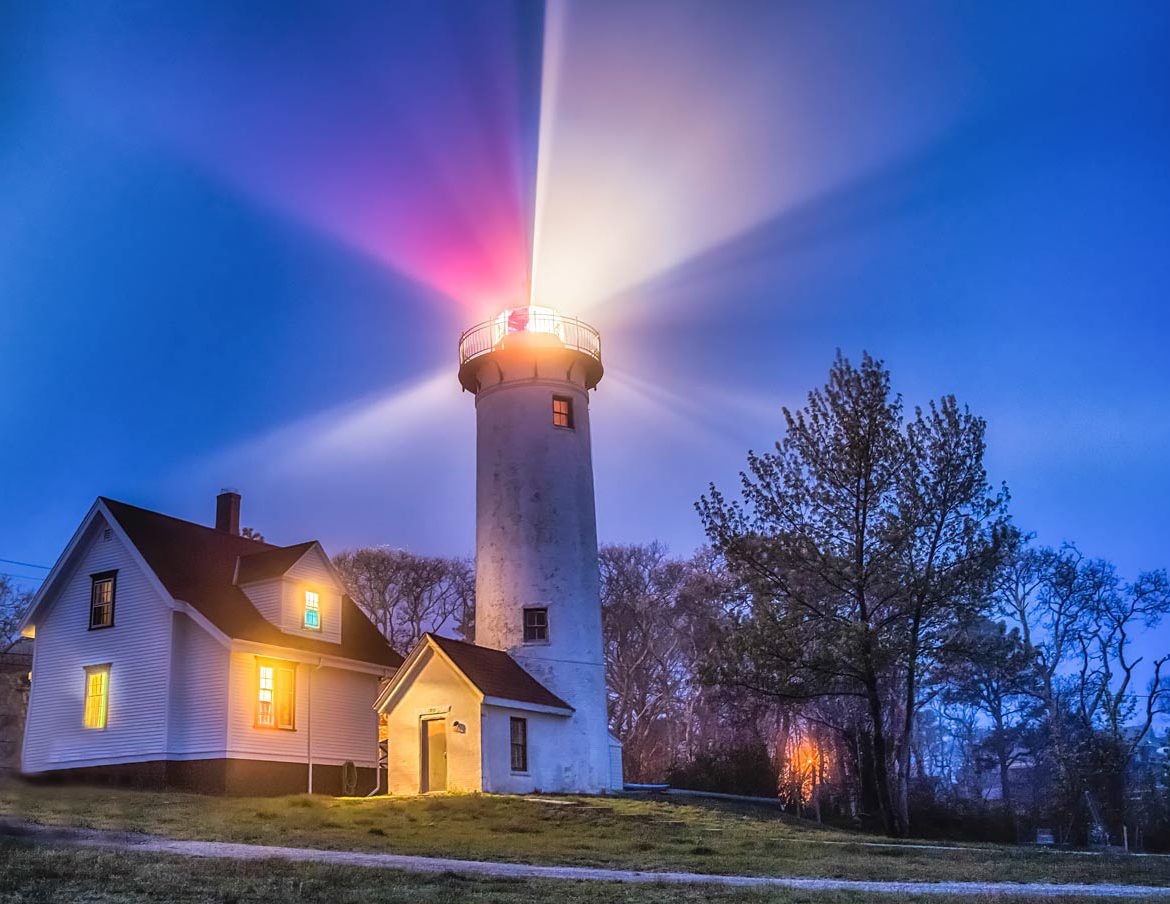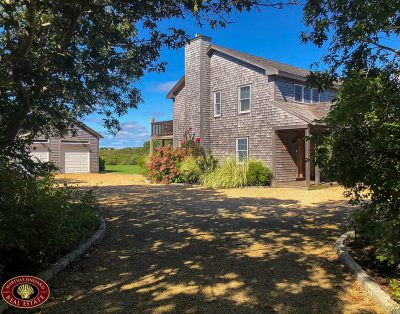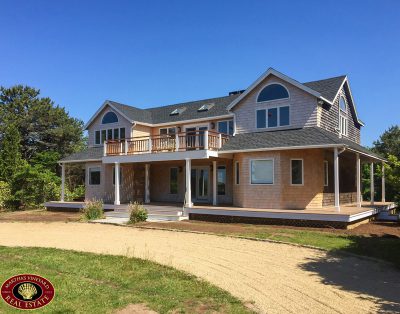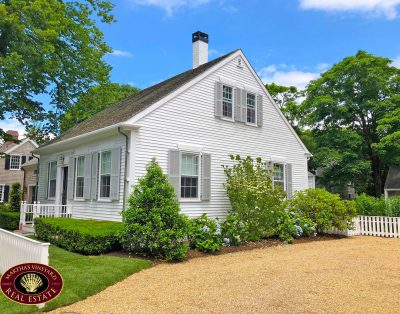The Lighthouses on Martha’s Vineyard
The five lighthouses of Martha’s Vineyard represent the most diverse group in a small, contained area in the country, according to lighthouse buffs. All of the lighthouses are on the north side of the Island: they look out over Vineyard Sound and Nantucket Sound, and over the entrance to Edgartown Harbor and Cape Poge.
The Five Lighthouses on Martha’s Vineyard
West Chop Lighthouse
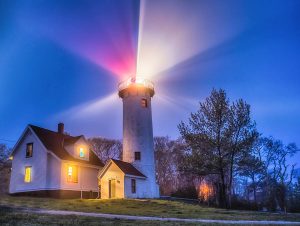 The West Chop Lighthouse was the Island’s last manned light. The lighthouse was built in 1817, and in 1838 the wooden building was replaced by the present brick structure. It was moved back from the edge of the 60-foot-high bluff in 1848 and again in 1891. In recent times, the small caretaker’s cottage at its foot has been occupied by Coast Guard personnel and is not open to the public. Vineyard Haven’s harbor has been recognized as a port of protection since 1645, and for 300 years it was one of the most important ports on the Atlantic coast. Originally called “Holmes Hole,” it acquired the name Vineyard Haven in 1871.
The West Chop Lighthouse was the Island’s last manned light. The lighthouse was built in 1817, and in 1838 the wooden building was replaced by the present brick structure. It was moved back from the edge of the 60-foot-high bluff in 1848 and again in 1891. In recent times, the small caretaker’s cottage at its foot has been occupied by Coast Guard personnel and is not open to the public. Vineyard Haven’s harbor has been recognized as a port of protection since 1645, and for 300 years it was one of the most important ports on the Atlantic coast. Originally called “Holmes Hole,” it acquired the name Vineyard Haven in 1871.
These lighthouses were beacons in history as well as in navigation, for Vineyard Sound and Nantucket Sound once saw more ships sail through them than any other place in the world except the English Channel. The opening of the Cape Cod Canal in 1914, as well as local weather conditions, changed this.
East Chop Lighthouse
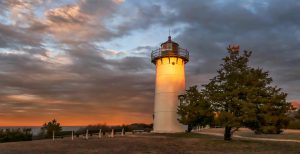 The East Chop Lighthouse in Oak Bluffs stands on the site of one of the first telegraph signals, set up in 1828. Signals from Nantucket were received here and relayed on to Woods Hole, Bonnedale, South Plymouth, Duxbury, Marshfield, and Dorchester Heights. A series of raised and lowered arms and flags conveyed news about cargos of ships arriving at Nantucket. The first ship to be announced in this way was The Mercury, bringing in treasures from Sumatra. Jonathan Grout, Jr. set up the system but operated it only six years. In the mid-1800s, Captain Silas Daggett built a privately owned lighthouse on East Chop. It was funded by local merchants who sailed in the area and by some of the ships passing through. Many, however, refused to pay a fee after they arrived safely in port and this, too, lasted only six years.
The East Chop Lighthouse in Oak Bluffs stands on the site of one of the first telegraph signals, set up in 1828. Signals from Nantucket were received here and relayed on to Woods Hole, Bonnedale, South Plymouth, Duxbury, Marshfield, and Dorchester Heights. A series of raised and lowered arms and flags conveyed news about cargos of ships arriving at Nantucket. The first ship to be announced in this way was The Mercury, bringing in treasures from Sumatra. Jonathan Grout, Jr. set up the system but operated it only six years. In the mid-1800s, Captain Silas Daggett built a privately owned lighthouse on East Chop. It was funded by local merchants who sailed in the area and by some of the ships passing through. Many, however, refused to pay a fee after they arrived safely in port and this, too, lasted only six years.
In 1875, the U.S. government bought the lighthouse and its land for $6,000 and the present cast-iron structure was built on the cliff 79 feet above the sea. Until 1988, when it was painted white, the East Chop Light was fondly called the Chocolate Lighthouse, for its brown-red color.
These lighthouses were beacons in history as well as in navigation, for Vineyard Sound and Nantucket Sound once saw more ships sail through them than any other place in the world except the English Channel. The opening of the Cape Cod Canal in 1914, as well as local weather conditions, changed this.
Edgartown Lighthouse
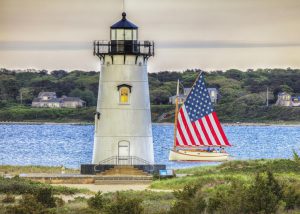 The original Edgartown Lighthouse was built in 1828, on a small man-made island in the Edgartown harbor. An Act of Congress allocated money to build it 1/4 mile from shore. Later, $5,500 was appropriated to complete the project and Seth Vincent was paid $80 for a right of way to the tower. For the first year, the only way to get to the light was by boat, but another $2,500 was allocated to build a foot bridge.
The original Edgartown Lighthouse was built in 1828, on a small man-made island in the Edgartown harbor. An Act of Congress allocated money to build it 1/4 mile from shore. Later, $5,500 was appropriated to complete the project and Seth Vincent was paid $80 for a right of way to the tower. For the first year, the only way to get to the light was by boat, but another $2,500 was allocated to build a foot bridge.
The first structure was replaced in 1938 by one that was rafted to the Vineyard from Ipswich. Although the new light was placed on the original site, sand had filled in the area between the island and the mainland, and the current Edgartown Lighthouse stands on shore.
The Island sits in treacherous seas, with one tide coming in from Boston, affecting the south side of the Vineyard, and another from Rhode Island, affecting the north shore. There are reefs, rocks, and shoals, and the infamous Devil’s Bridge off Aquinnah, which wrecked the steamship The City of Columbus on January 18, 1884, with the loss of 120 crew and passengers in the icy waters.
Cape Pogue Lighthouse
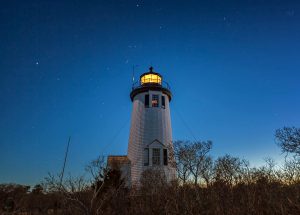 The Cape Poge Lighthouse is by far the Island’s most remote, built in 1801 when an Act of Congress appropriated $2,000 for it. A 4-acre site was purchased for $36 from Marshal Jenkins, Martin Pease, and Joseph Huxboro.
The Cape Poge Lighthouse is by far the Island’s most remote, built in 1801 when an Act of Congress appropriated $2,000 for it. A 4-acre site was purchased for $36 from Marshal Jenkins, Martin Pease, and Joseph Huxboro.
The original lighthouse was made of wood and had a small caretaker’s cottage. By 1838, the building was destroyed by the ravaging sea and rebuilt farther inland. It lasted only 50 years before the sea again claimed it and it was rebuilt, with a change from reflector lamps to red and white revolving prisms.
The sea would not be denied, and reclaimed the lighthouse in 1892. It was rebuilt as a 33-foot-tall tower that lasted only another 35 years.
The present white wooden structure was built in 1922, 55 feet high with a light visible for a distance of 12 miles. In 1985 it gained the distinction of being the first entire lighthouse to be moved by helicopter; in 1997 the lantern was again moved by helicopter for repairs. The lighthouse’s present site is 300 feet from the ever-hungry sea.
All of the Island’s lighthouses, except the Cape Poge Lighthouse, are easily accessible by road. The Trustees of Reservations (508.627.3599) offer tours of the Cape Poge Lighthouse. The MV Museum (508.627.4441) has information about the East Chop Lighthouse, the Edgartown Lighthouse and the Gay Head Lighthouse.
Gay Head Lighthouse
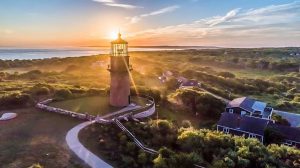 The Gay Head Lighthouse has always been perilously close to the ever-eroding cliffs. The red brick light was built in 1844 to replace a wooden tower authorized by President John Quincy Adams. In 1856, the marvelous Fresnel lens with its 1,009 prisms was installed, after having been proudly exhibited at the World’s Fair in Paris. It is now preserved at the Martha’s Vineyard Historical Society in Edgartown, and is lighted every evening after dark throughout the year.
The Gay Head Lighthouse has always been perilously close to the ever-eroding cliffs. The red brick light was built in 1844 to replace a wooden tower authorized by President John Quincy Adams. In 1856, the marvelous Fresnel lens with its 1,009 prisms was installed, after having been proudly exhibited at the World’s Fair in Paris. It is now preserved at the Martha’s Vineyard Historical Society in Edgartown, and is lighted every evening after dark throughout the year.
The Gay Head, East Chop, and Edgartown Lighthouses are maintained by the Martha’s Vineyard Historical Society under a 30-year lease with the United States Coast Guard. Each light has a large, fenced-in park area that makes a perfect place to relax and enjoy the island’s view. The Gay Head and East Chop Lighthouses are open for sunset tours from late June through mid-September, from 1.5 hours before sunset to 0.5 hour after. The Gay Head Lighthouse is open Friday to Sunday; the East Chop Lighthouse just Sundays. Musicians and vocalists often perform impromptu. A $3 admission fee is requested for adults; children under 12 are admitted free.
The East Chop, Edgartown and Gay Head Lighthouses are available for wedding ceremonies and other special events. Call the Martha’s Vineyard Museum at 508.627.4441. Tax-deductible donations to help save the lights may be designated as “lighthouse donations” and mailed to The Martha’s Vineyard Museum, P.O. Box 1310, Edgartown MA 02539.
Information Courtesy of Martha’s Vineyard Museum and Historical Society: http://www.mvmuseum.org/
Photos Courtesy of Michael Blanchard Photography


